Contents
Market Overview
Macro Review
The “peak inflation” and “peak dollar” narrative dominates. The Fed’s Daly and Kashkari may have suggested it is too soon to declare victory on inflation, but we have nevertheless seen a dip. Headline U.S. inflation for July came in at 8.5%, lower than the 9.1% registered in June. Daly spelt out why a half-percentage point rate rise in September was her “baseline”, which along with comments from Evans and Kashkari helped dial the needle back from 75bps, just as U.S. Treasury 2s10s bear steepened back to -30-40bps. Meanwhile, the inflation surprise index for emerging markets has been trending down since May. Then again, global PMI activity components also fell below the 50 threshold for the first time since June 2020. It was down 1.7pts to 48.7. Asia ex-Japan and China reflects the only region which increased over the month (+0.4pt). At the same time, consensus growth for China dipped below 4% for 2022 for the first time to 3.9%, although this is only closer to the IMF’s 3.3% estimate. Aside from the 1% USD weakness, EMFX strength, 4% oil rally, VIX dipping below 20, U.S. equities stabilizing and muted returns in U.S. credit, emerging markets was the outperforming asset class this week. Both EM fixed income and EM equities were on par with one another, up 1.5-2.5%.
EM Credit Update
Emerging markets sovereign credit ended the week up 1.6% with spreads 31bps tighter. Outperformers over the week were Zambia, Tunisia and Ethiopia while Ukraine, Tajikistan and Sri Lanka underperformed. China’s Logan Group missed an interest payment which cross-defaulted into the $3.7bn debt stack and will increase default rates as $3.2bn of the debt was index-eligible. Additionally, Ukraine’s consent solicitation was approved, allowing the sovereign to defer coupon payments to November 2024. However, holdouts amounted to 25% and non-payment on the 8.994% 2024s coupon, mean a credit event is likely to be triggered in the credit default swaps. Notwithstanding, the bond instruments are trading flat of accrued interest, which is common among defaulted bonds. Elsewhere, the GBI-EM posted its second highest daily return in 2022 on Wednesday after the soft U.S. CPI print as EMFX rallied substantially. For context, the GBI-EM did not rally more than 1.2% on a single trading day in 2021.
The Week Ahead
Fed minutes, New Zealand’s rate decision, Euro-area inflation and Japan’s 2Q GDP are the major G10 events. Across EM, it’s the PBoC rates decision and China’s July activity data that is likely to be the key focus next week. This release comes alongside industrial production, investment and retail sales. Interest rate decisions from Egypt (11.25%), Philippines (3.25%), Turkey (14.0%) and Uruguay (9.75%) stand out. Then GDP releases are also due out of Brazil, Chile, Poland, Romania and Thailand, but the focus will also be on Poland’s inflation release. As a reminder from our EM Weekly edition on July 22, the National Bank of Poland forecasts core CPI to peak in 4Q22 and headline to peak in 1Q23.
Highlights from emerging markets discussed below include: Kenya’s presidential election, the Peruvian cabinet reshuffle and Turkey’s balance of payment data.
Fixed Income
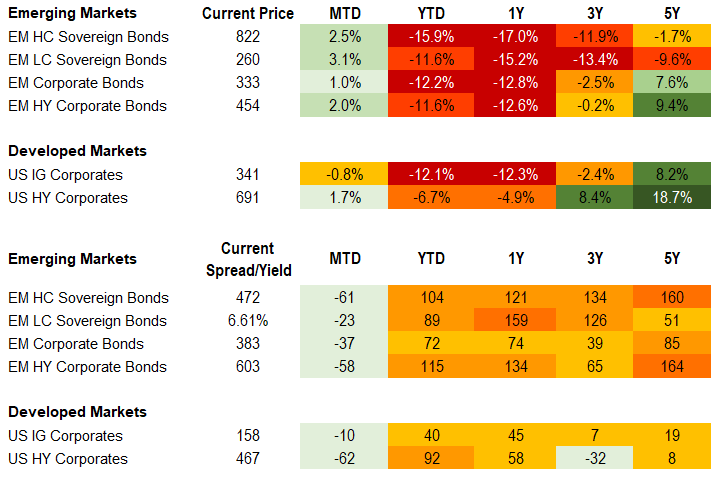
Equities
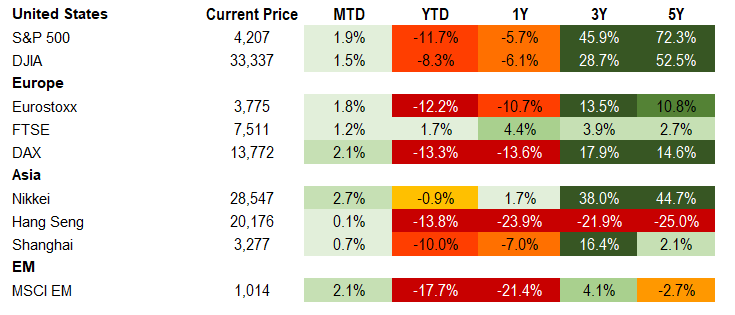
Commodities

Source for data tables: Bloomberg, JPMorgan, Gramercy. EM Fixed Income is represented by the following JPMorgan Indicies: EMBI Global, GBI-EM Global Diversified, CEMBI Broad Diversified and CEMBI Broad High Yield. DM Fixed Income is represented by the JPMorgan JULI Total Return Index and Domestic High Yield Index. Fixed Income, Equity and Commodity data is as of August 12, 2022 (mid-afternoon).
Emerging Markets Weekly Highlights
Kenya presidential election close race with low turnout
Event: Kenya held presidential elections on August 9th where voters decided between opposition candidate, Raila Odinga, and the Deputy President, William Ruto. With nearly 90% of votes counted at the time of writing, the outcome has narrowed to a very thin margin with Ruto at 50% and Odinga at 49%. Turnout is estimated to be around 60%, which pales in comparison to recent elections where 2017 and 2013 participation were 78% and 86%, respectively. To secure a first-round victory, candidates need more than 50% of total votes and at least 25% of votes from 50% of 47 counties. If there is no outright winner, a second-round election will be held in 30 days.
Gramercy commentary: We do not expect overly disruptive unrest or contested election dynamics particularly given growing political apathy as reflected by the drop in turnout, despite the very close race. Given the thin margin between candidates, prospects for a second-round are high. The market’s focus remains on the fiscal and broader policy outlook of the next administration with it giving some benefit of the doubt to Ruto and policy continuity with bonds up on his initial lead. We see greater uncertainty under an Odinga victory in context of prior comments on debt restructuring and indications of swifter policy deterioration, posing risk to the existing IMF EFF facility, of which roughly $900 remains undisbursed. Regardless of the outcome, continued pressure on the large twin deficits will remain a challenge for the credit, leaving asset prices subject to elevated volatility.
Peru cabinet reshuffle leads to new Finance Minister
Event: Following Castillo’s rejection of Prime Minister Anibal Torres’ resignation earlier this week, he appointed a new Finance Minister, Kurt Burneo, replacing technocrat Oscar Graham. The reshuffle also includes new appointments of Foreign, Housing, Culture, Labor, and Transport Ministers. Burneo previously served as Production Minister under President Humala and Vice Minister of Finance under President Toledo.
Gramercy commentary: While Burneo is seen as having more political clout than Graham, we see continued gridlock due to seemingly insurmountable governability challenges. His initial comments on increased harmonization of monetary and fiscal policy give investors some pause on central bank autonomy but at this juncture, we think that Velarde and the BCRP’s autonomy remain intact. Going forward, broader pressures on Castillo are likely to persist with ongoing impeachment risks.
Turkey balance of payment data points to CAD financed largely by unidentified inflows
Event: The June CAD figure of $3.5bn was slightly worse than expected but narrowed sequentially from $6.6bn in May. The YTD deficit is $32.5bn, just over double the deficit in 1H21 in nominal terms, led in large part by energy imports. The services balance improved on the month thanks to tourism flows while the goods balance remained pressured. For the first half of the year, net FDI inched higher to $2.9bn from $2.7bn mainly related to real estate flows while portfolio outflows were $11.4bn compared to $2bn of inflows in 1H21. Errors and omissions flows reached a high of $17.5bn.
Gramercy commentary: We see the data as indicative of a current account deficit of 5.5-6.0% of GDP, depending in part on the evolution of tourism and oil prices in 2H22. As errors and omissions swings can be volatile and a bit of a black box, likely in part caused by the current policy mix and inflationary impulse, this poses uncertainty regarding CAD financing over the coming quarters, potentially weighing on FX reserves and the lira.
Emerging Markets Technicals
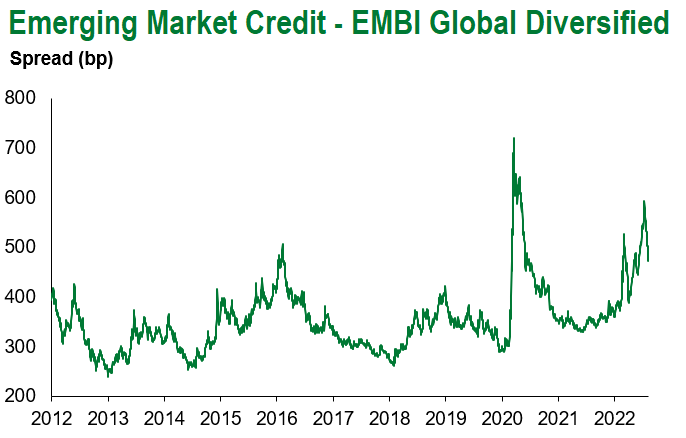
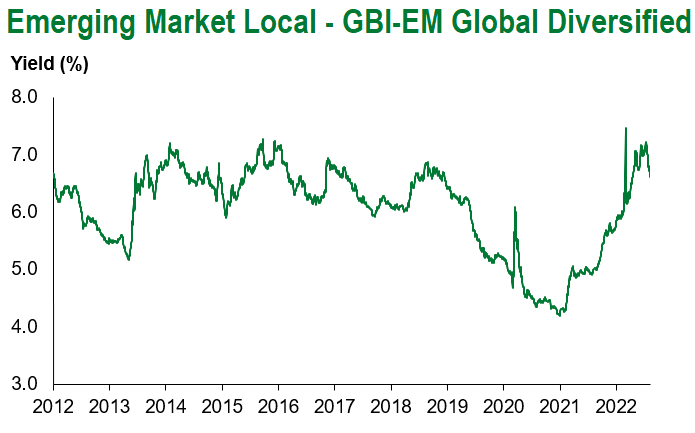
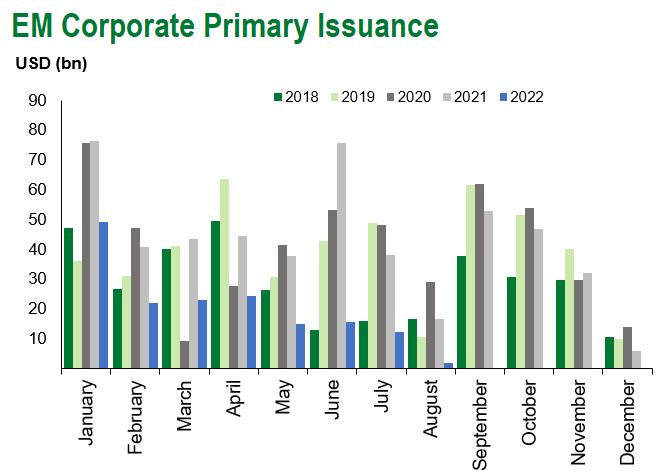
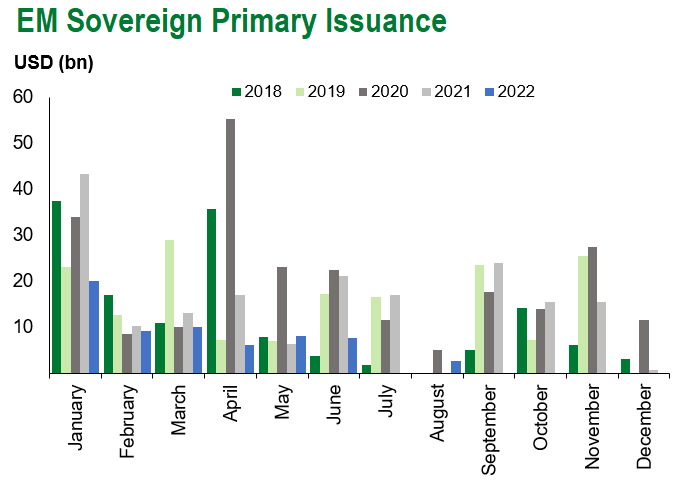
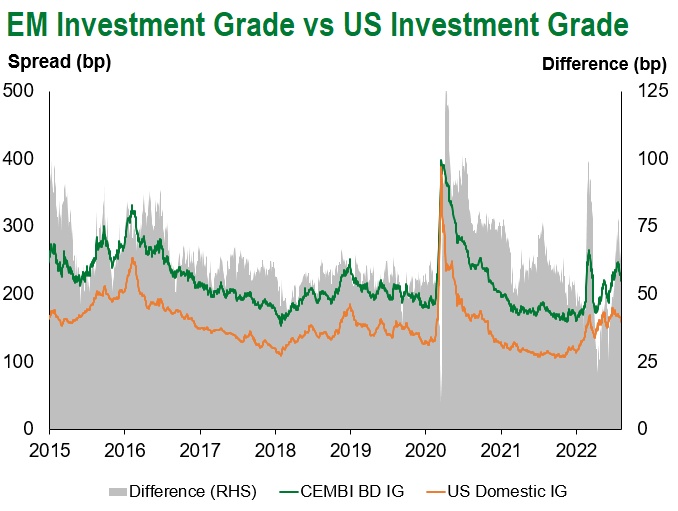
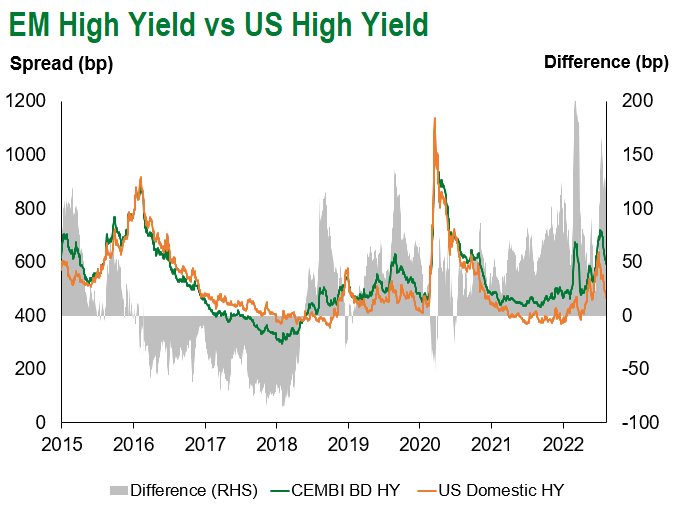
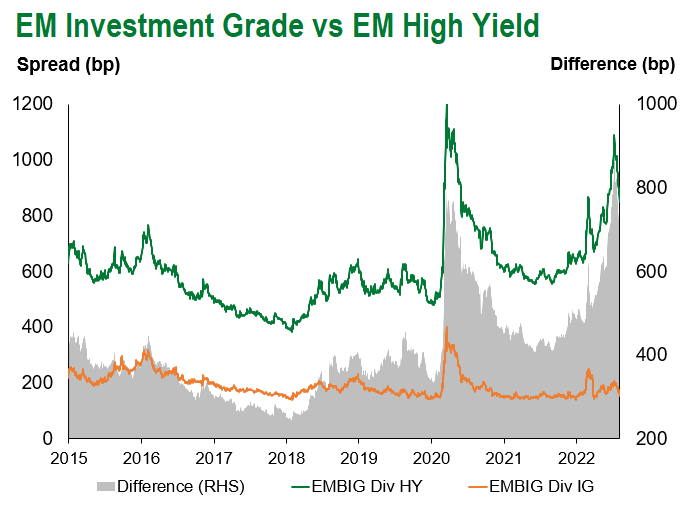
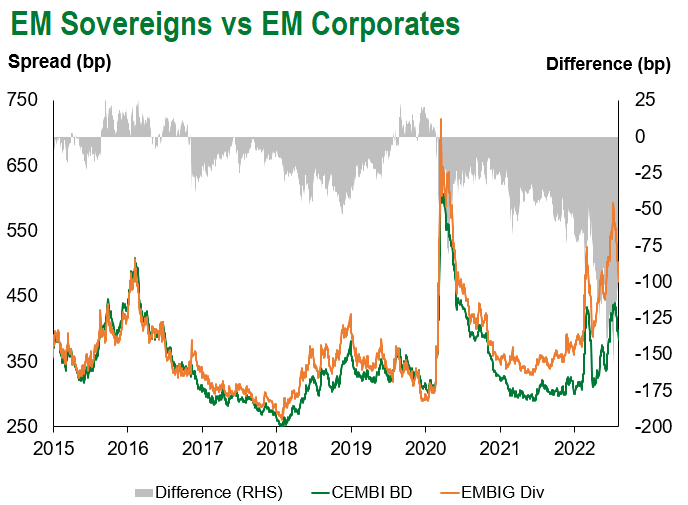
Emerging Markets Flows
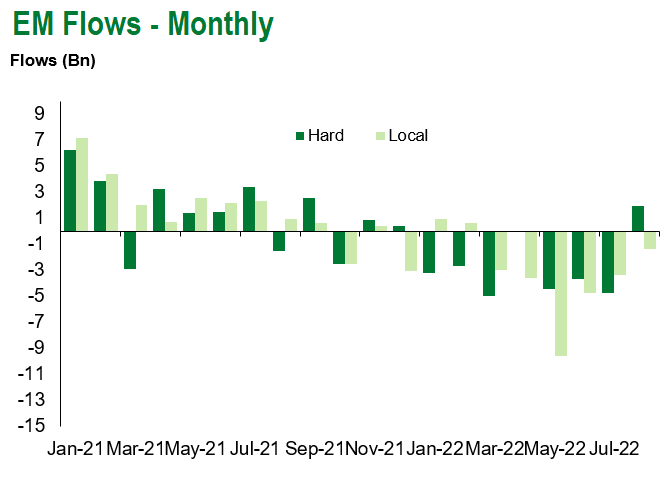
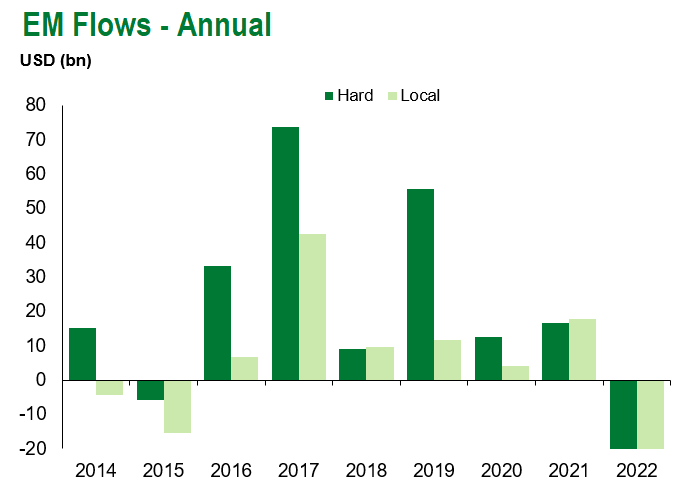
Source for graphs: Bloomberg, JPMorgan, Gramercy. As of August 12, 2022.
COVID Resources:
Johns Hopkins COVID-19 Case Tracker
For questions, please contact:
Kathryn Exum, CFA ESG, Director, Co-Head of Sovereign Research, [email protected]
Petar Atanasov, Director, Co-Head of Sovereign Research, [email protected]
James Barry, Director, Deputy Portfolio Manager, [email protected]
This document is for informational purposes only. The information presented is not intended to be relied upon as a forecast, research or investment advice, and is not a recommendation, offer or solicitation to buy or sell any securities or to adopt any investment strategy. Gramercy may have current investment positions in the securities or sovereigns mentioned above. The information and opinions contained in this paper are as of the date of initial publication, derived from proprietary and nonproprietary sources deemed by Gramercy to be reliable, are not necessarily all-inclusive and are not guaranteed as to accuracy. This paper may contain “forward-looking” information that is not purely historical in nature. Such information may include, among other things, projections and forecasts. There is no guarantee that any forecasts made will come to pass. Reliance upon information in this paper is at the sole discretion of the reader. You should not rely on this presentation as the basis upon which to make an investment decision. Investment involves risk. There can be no assurance that investment objectives will be achieved. Investors must be prepared to bear the risk of a total loss of their investment. These risks are often heightened for investments in emerging/developing markets or smaller capital markets. International investing involves risks, including risks related to foreign currency, limited liquidity, less government regulation, and the possibility of substantial volatility due to adverse political, economic or other developments. The information provided herein is neither tax nor legal advice. Investors should speak to their tax professional for specific information regarding their tax situation.
